Orchids are a diverse and exotic family of plants, and one of the most popular varieties is the Vanda. These stunning flowers are native to the tropical regions of Asia and are known for their vibrant colors and intricate patterns. There are many types of Vanda orchids, each with unique characteristics and growing requirements.
In this blog, we will explore some of the different kinds of Vanda orchids, as well as their care and cultivation needs. Whether you are a seasoned orchid enthusiast or a beginner looking to add color to your garden, the Vanda orchid is a beautiful and rewarding choice.

Contents
- 1 15 Popular Types Of Vanda Orchids
- 1.1 Vanda Miss Joaquim
- 1.2 Vanda sanderiana
- 1.3 Vanda tricolor
- 1.4 Vanda coerulea
- 1.5 Vanda denisoniana
- 1.6 Vanda tessellata
- 1.7 Vanda Robert’s Delight
- 1.8 Vanda lamellata
- 1.9 Vanda coerulescens
- 1.10 Vanda cristata
- 1.11 Vanda sumatrana
- 1.12 Vanda merrillii
- 1.13 Vanda liouvillei
- 1.14 Vanda pumila
- 1.15 Vanda javierae
- 2 How To Care For Vanda Orchids
- 3 How To Propagate Vanda Orchids
- 4 Frequently Asked Questions
- 4.1 How many varieties of Vanda orchids are there?
- 4.2 How do I identify my Vanda orchid?
- 4.3 What is the rarest Vanda orchid?
- 4.4 What colors do Vanda orchids come in?
- 4.5 Why is blue Vanda prohibited?
- 4.6 How long does it take a Vanda to flower?
- 4.7 How often do Vanda orchids flower?
- 4.8 How long do Vanda orchids last?
- 4.9 Can Vanda orchids take full sun?
- 4.10 How often should Vandas be watered?
- 4.11 Can you overwater a Vanda?
- 4.12 Can Vanda grow in pots?
- 4.13 Do Vandas need soil?
15 Popular Types Of Vanda Orchids
Vanda Miss Joaquim
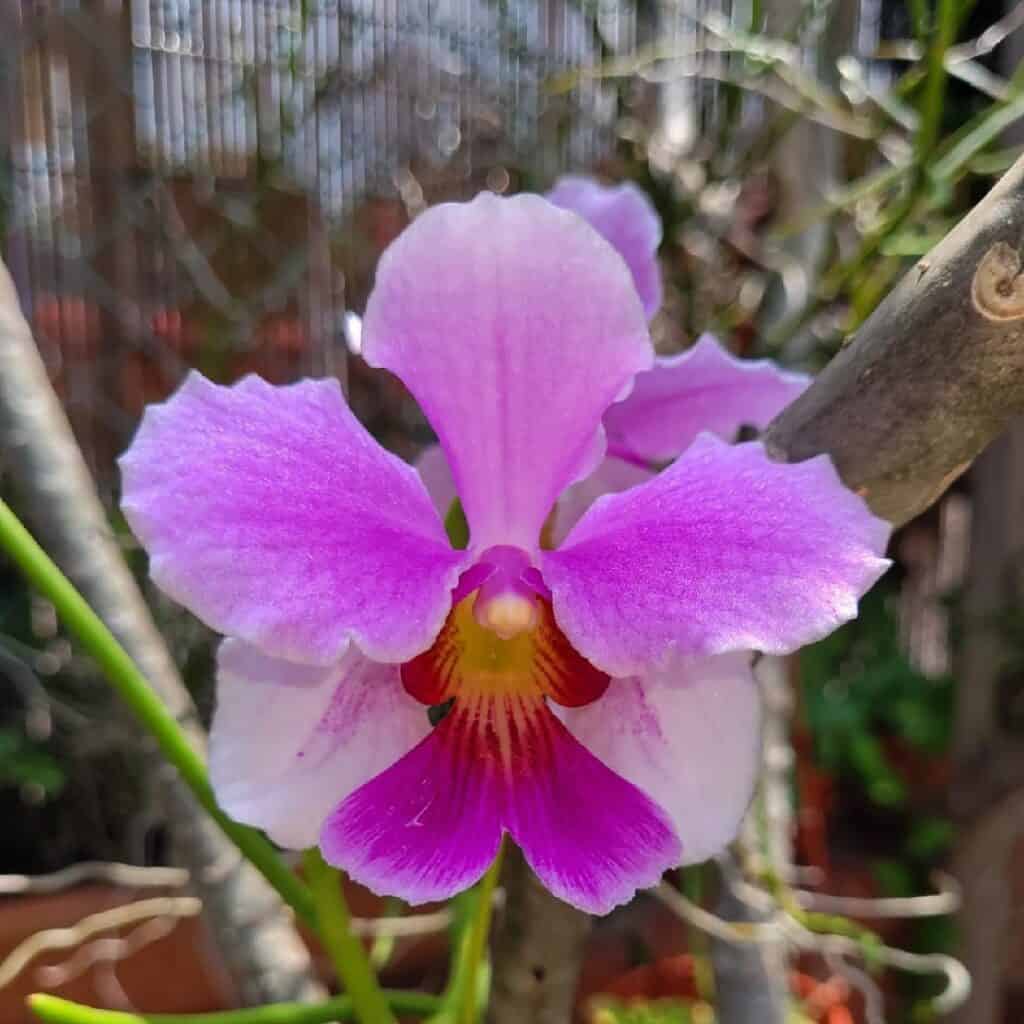
Vanda Miss Joaquim, also known as the Singapore orchid and Princess Aloha orchid, is Singapore’s national flower.
Vanda sanderiana

Vanda sanderiana is a species of orchid native to the Philippines. It is commonly known as Waling-waling and Sander’s Vanda. The orchid is considered to be the “Queen of Philippine flowers” and is worshiped by indigenous Bagobo tribes as a diwata.
Vanda tricolor
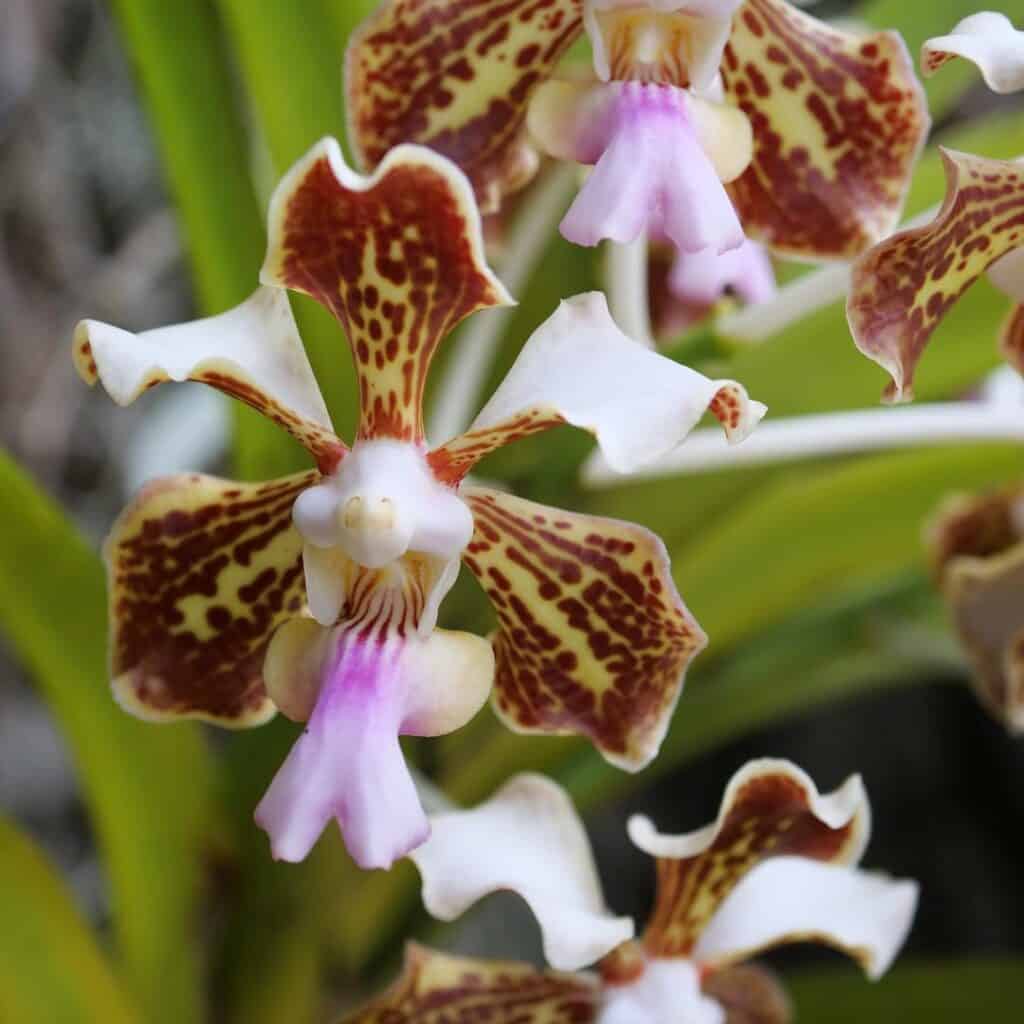
The Vanda tricolor complex encompasses many colorful varieties of a wide-ranging Indonesian species found in Laos, Java, Bali, Lombok and Sumbawa.
Vanda coerulea

Known by the name blue orchid, blue vanda, or autumn lady’s tresses, Vanda coerulea is an orchid found in Northeast India with a range extending to China. In Manipuri, it is known as kwaklei, and in Sanskrit, it is called vandaar. The flowers are bluish-purple and very long-lasting.
Vanda denisoniana

The Vanda denisoniana orchid grows in southern China through southeast Asia. It produces small yellow, waxy flowers in late fall or early spring, which produce a strong vanilla scent in the evenings.
Vanda tessellata
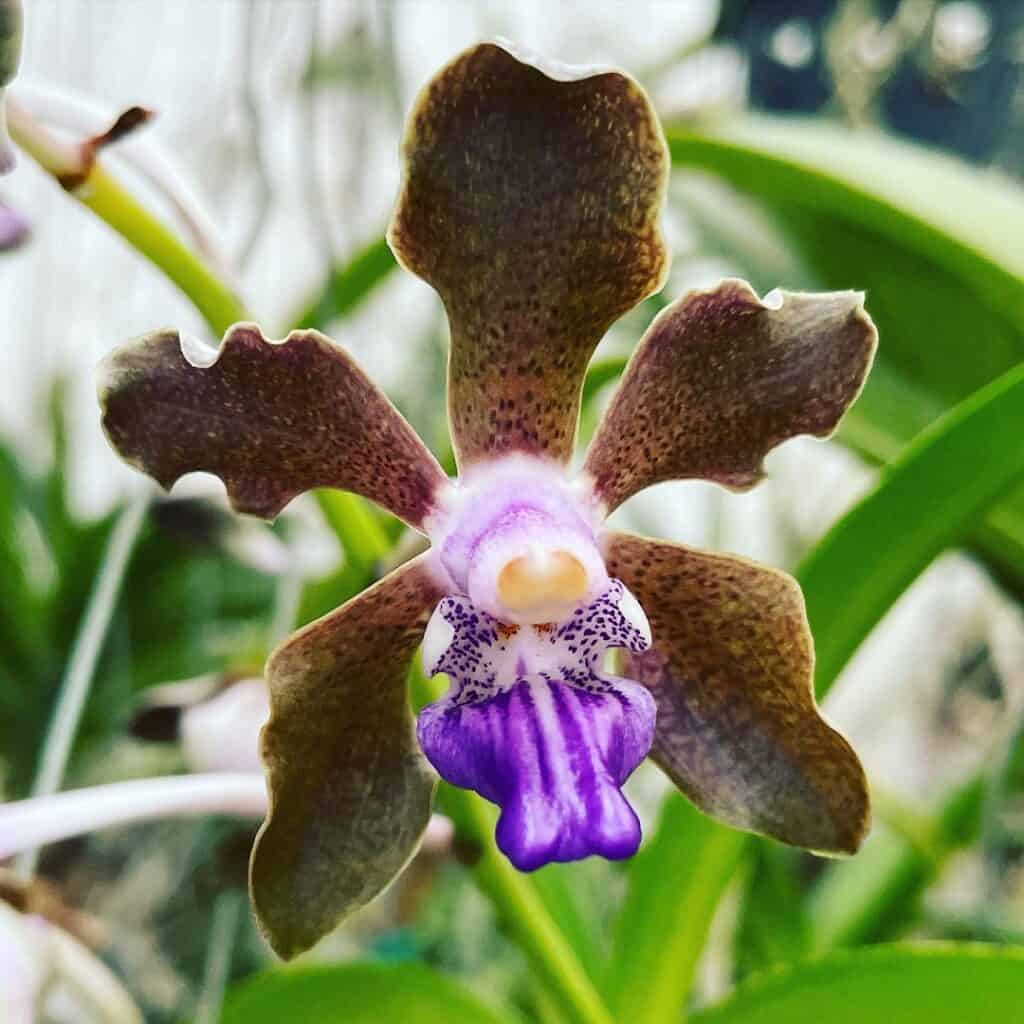
Known also as the Gray orchid or Checkered Vanda, Vanda tessellata occurs from India to Indochina. This hybrid orchid has semi-terete leaves that make it smaller than strap-leafed vandas. It features tan/brown petals and sepals with a purple lip that contrasts beautifully with the flowers.
Vanda Robert’s Delight
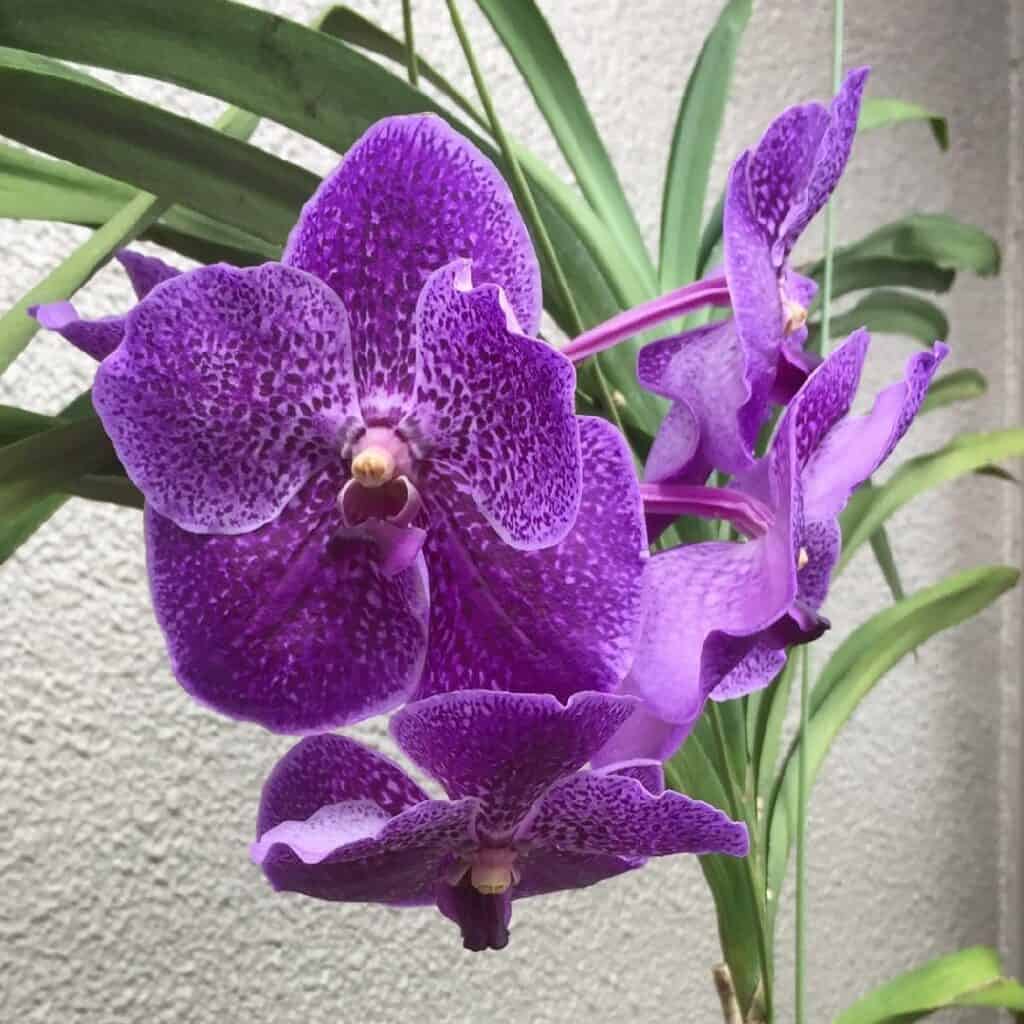
Vanda Robert’s Delight has sizable dark purple blooms and is a cross between V. Kasem’s Delight and V. Madame Rattana.
Vanda lamellata
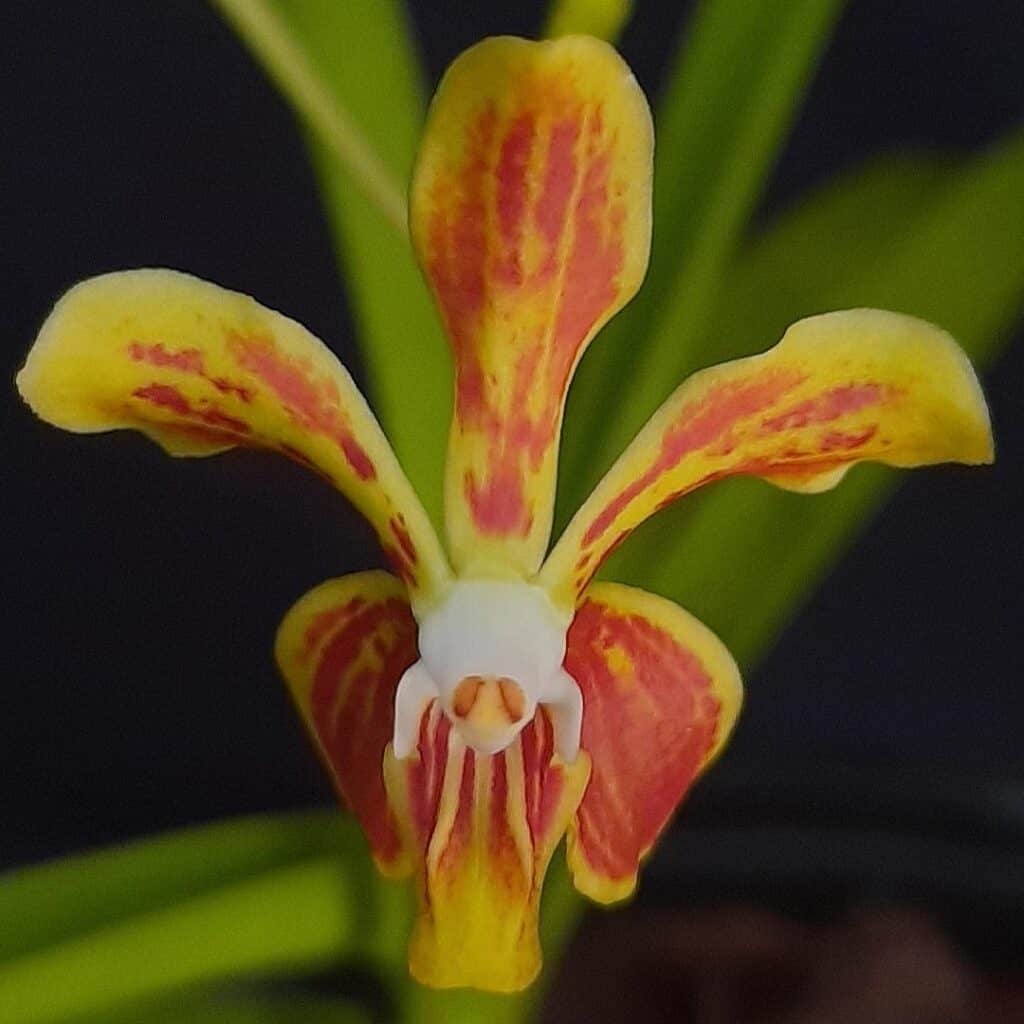
Vanda lamellata is a compact and elegant orchid found on the Japanese Ryukyu Islands, Taiwan, and northern Malaysian Borneo.
Vanda coerulescens

Vanda coerulescens, also called sky-blue vanda, is a monopodial orchid with branching sprays of 1-2 inch flowers colored in lilac blue with an indigo-blue lip, or pink with a red lip.
Vanda cristata
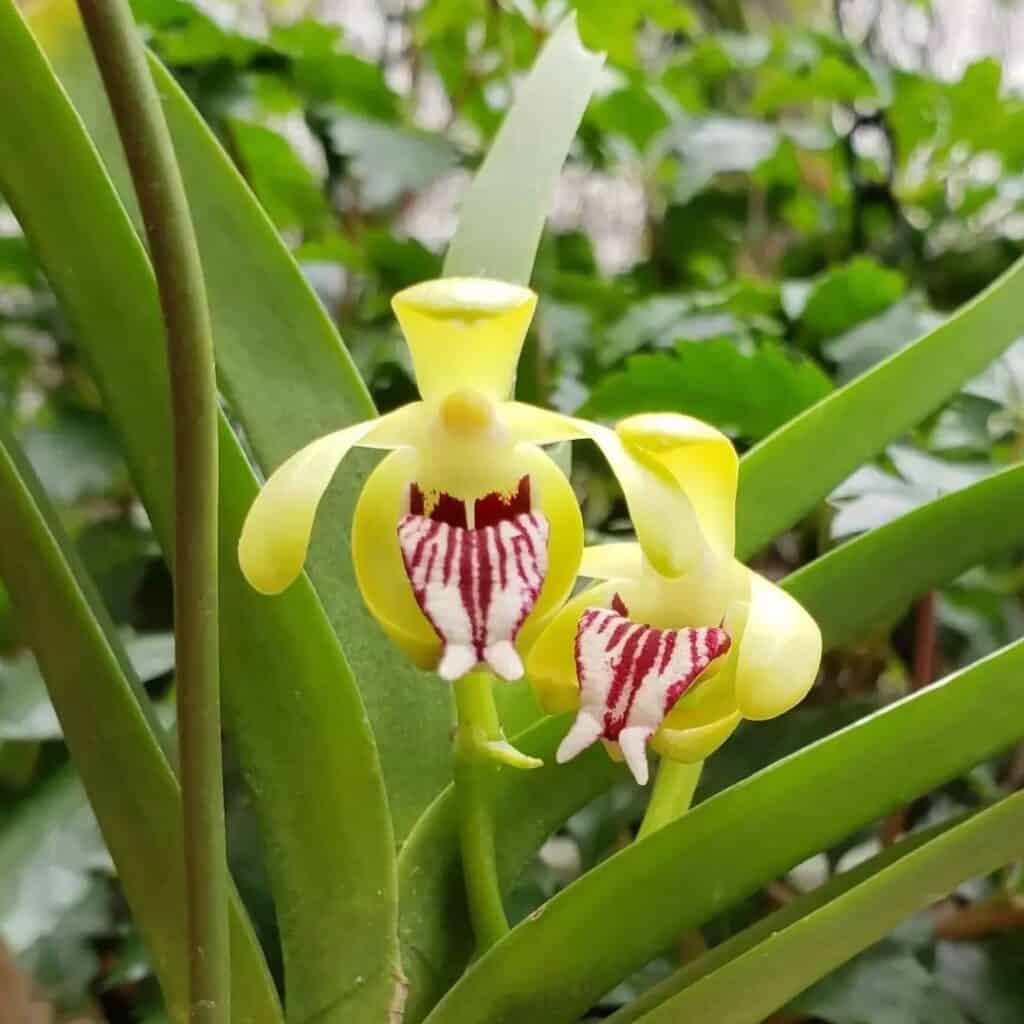
Vanda cristata is a small- to medium-sized species that originates in Asia and is known for its amazing lip, which makes it a favorite for hybridizing, as well as its precocious blooming habit and fragrant flowers. Plants can grow quite big, but they bloom when they’re just a little big, and they have long-lasting flowers.
Vanda sumatrana
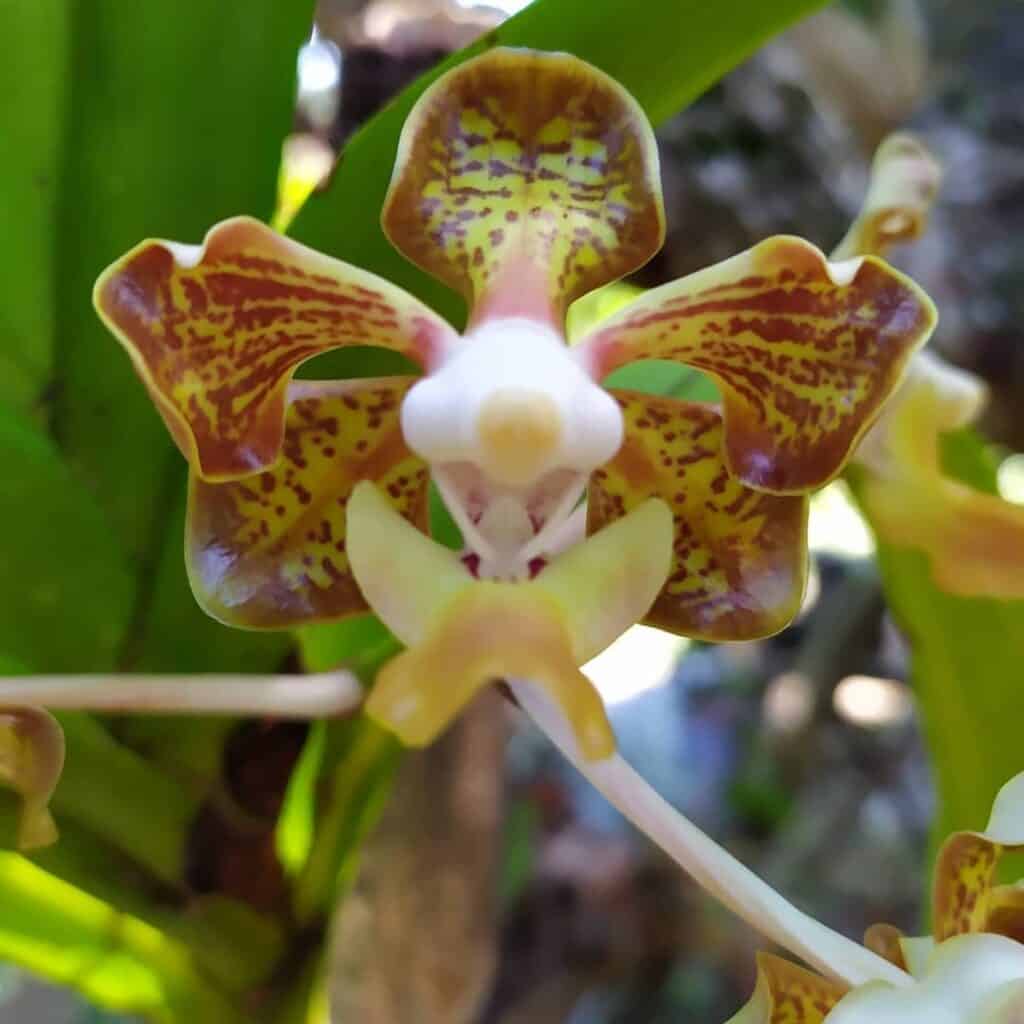
Vanda sumatrana is an uncommon species from Sumatra that produces smoky-sweet fragrances. The species will bloom several times per year.
Vanda merrillii
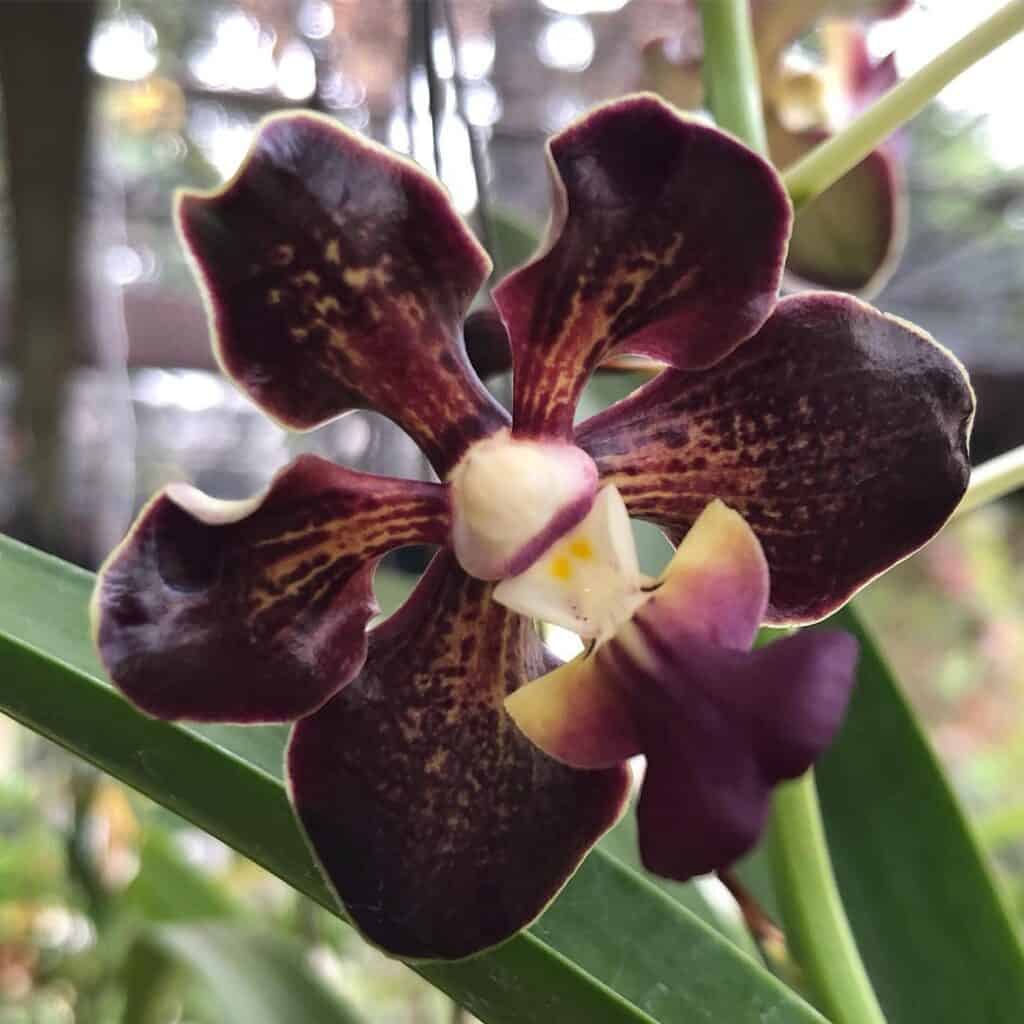
Vanda merrillii is a beautiful species native to the Philippines. The deep mahogany red flowers have a sweet fragrance.
Vanda liouvillei
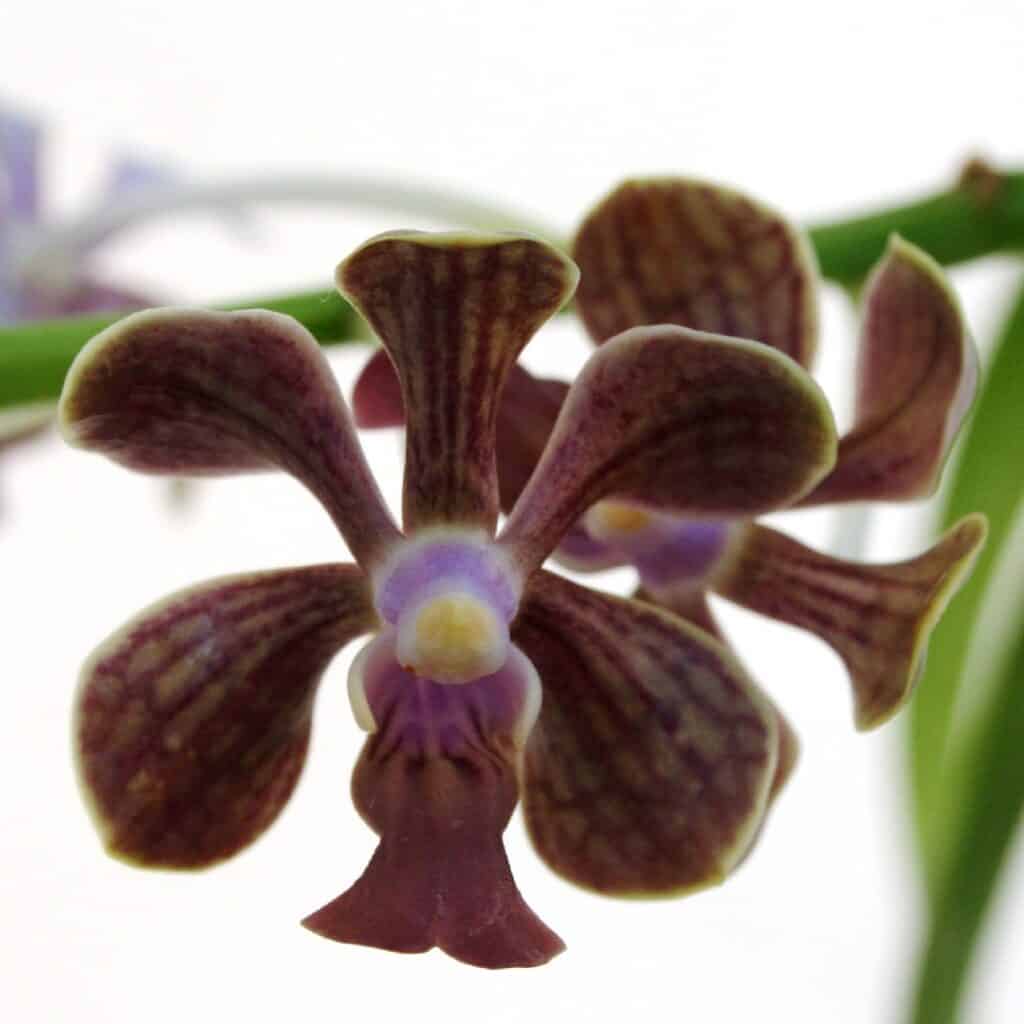
The Vanda liouvillei is a medium-sized, warm to cool epiphyte, with erect stems and strap-shaped leaves. It is similar to Vanda brunnea, but has larger flowers and blooms on an axillary, with slightly fragrant flowers in late winter and early spring.
Vanda pumila

Vanda pumila is a small-sized native to Asia. It blooms at a small age, and the flowers last for a long time. The flowers are greenish-yellow with yellow markings.
Vanda javierae

A beautiful white vanda, Vanda javierae is commonly known as Mrs. Javier’s vanda.
How To Care For Vanda Orchids
Vanda orchids are some of the most popular and beautiful orchids in the world, and they’re surprisingly easy to grow. With the right care and attention, you can have a thriving vanda orchid garden in no time.
Light
Vanda orchids require bright, indirect light. They can tolerate some direct sun, but it is important to protect them from the intense midday sun, which can scorch their leaves. A south- or west-facing window is often a good location for vanda orchids, as long as the plants are not too far from the window.
Water
Vanda orchids should be watered once or twice a week, depending on the humidity and temperature in their environment. It is important to let the potting mix dry out slightly between waterings, as vanda orchids are prone to root rot if they are kept too moist. Water the plants early in the day so that the leaves have time to dry before nightfall.
Temperature and Humidity
Vanda orchids prefer warm temperatures, ideally between 70 and 90 degrees Fahrenheit. They also require high humidity, which can be achieved by misting the plants regularly or placing them on a humidity tray.
Potting Mix
Vanda orchids should be potted in a mix that is well-draining and high in organic matter. A mix of bark, perlite, and sphagnum moss is often recommended.
Pruning
Vanda orchids should be pruned regularly to remove any dead or damaged leaves and flowers. This will encourage the plants to produce new growth and flowers. When pruning, use sterilized pruning tools and make clean cuts above a node (a point where leaves or flowers emerge from the stem).
How To Propagate Vanda Orchids
There are several methods of propagating Vanda orchids, including dividing the plant, taking stem cuttings, and growing them from seed.
Dividing the Plant
Vanda orchids can be propagated by dividing the plant when it becomes overcrowded or when it is dormant. To do this, carefully remove the plant from its pot and gently separate the individual pseudobulbs with a sharp knife or scissors. Each pseudobulb should have a few roots attached to it. Replant the divisions into separate pots with a well-draining potting mix.
Taking Stem Cuttings
Vanda orchids can also be propagated from stem cuttings. To do this, cut a stem with a few leaves on it and remove the lower leaves. Dip the cut end of the stem in rooting hormone and place it in a potting mix or hydroponic system. Keep the potting mix moist but not wet and provide the cutting with high humidity and indirect light.
Growing Them From Seed
Vanda orchids can be grown from seed, but this method is more challenging and time-consuming. The seeds are very small and require specific growing conditions, such as high humidity and constant airflow. The seeds should be sown on a sterile, well-draining medium and kept in a greenhouse or other controlled environment. It can take several years for the seedlings to mature into flowering plants.
Frequently Asked Questions
How many varieties of Vanda orchids are there?
There are many varieties of Vanda orchids, and it is difficult to give an exact number as new varieties are constantly being created through hybridization. Some sources estimate that there are around 50-60 recognized species within the Vanda genus.
How do I identify my Vanda orchid?
To identify your Vanda orchid, you can start by looking at its physical characteristics, such as the shape and size of its flowers, the color and pattern of its petals, and the number of petals it has. You can also look at the shape and size of its leaves, as well as the type of stem it has. Additionally, you can consult a field guide or a specialist in orchid identification to help determine the specific species or hybrid of your Vanda orchid.
What is the rarest Vanda orchid?
It is difficult to determine which Vanda orchid is the rarest, as this can depend on a variety of factors such as the region in which it is found, the demand for it among collectors, and its cultivation and preservation efforts. Some rare Vanda orchids may be endangered due to habitat loss or other environmental factors.
What colors do Vanda orchids come in?
Vanda orchids come in a wide range of colors, including shades of red, orange, yellow, green, blue, purple, pink, and white. They can also have patterns or markings on their petals, such as spots or stripes.
Why is blue Vanda prohibited?
Blue Vanda orchids are often prohibited because they are rare and highly sought after by collectors, which can lead to overcollection and exploitation of wild populations. In some cases, the trade of blue Vanda orchids may also be regulated by conservation laws to help protect and preserve these rare plants.
How long does it take a Vanda to flower?
The time it takes for a Vanda orchid to flower can vary depending on the specific species or hybrid, as well as factors such as the age of the plant, the growing conditions it is provided with, and its overall health. Some Vanda orchids may take several months to several years to flower, while others may flower more quickly.
How often do Vanda orchids flower?
The frequency with which Vanda orchids flower can also vary depending on the specific species or hybrid, as well as the growing conditions it is provided with. Some Vanda orchids may flower only once a year, while others may flower multiple times throughout the year.
How long do Vanda orchids last?
It is difficult to give a specific answer to how long Vanda orchids last, as it can depend on various factors such as the care they receive, the environment they are grown in, and their natural lifespan. Some Vanda orchids may only last a few years, while others may live for several decades.
Can Vanda orchids take full sun?
Vanda orchids can tolerate some direct sunlight, but they generally prefer partial shade or filtered sunlight. It is important to protect them from intense midday sun, as this can cause their leaves to become scorched or bleached.
How often should Vandas be watered?
Vanda orchids should be watered regularly, but it is important to allow the growing medium to dry out slightly between waterings. Overwatering can lead to root rot and other problems, so it is important to be mindful of the moisture level in the potting medium.
Can you overwater a Vanda?
Yes, it is possible to overwater a Vanda orchid. Vandas are epiphytic orchids, meaning that they grow on other plants or objects rather than in soil. This means that they do not require as much water as terrestrial plants. Overwatering a Vanda can lead to the roots becoming waterlogged and rotting, which can be deadly for the plant. It is important to allow the roots of a Vanda to dry out somewhat between waterings, as the plant takes up water through its roots.
If you are unsure whether your Vanda needs water, it is best to check the roots and the potting medium to see if they are dry before watering the plant.
Can Vanda grow in pots?
Vanda orchids can be grown in pots, but they may require special care and attention. They generally prefer a well-draining potting mix that is high in organic matter and provides good aeration. Some Vanda orchids may also benefit from being mounted on slabs of wood or other supports, as this allows for better air circulation around the roots.
Do Vandas need soil?
Vanda orchids do not necessarily need soil to grow, as they can also be grown in other types of potting media such as coconut coir or sphagnum moss. However, it is important to provide them with the proper nutrients and moisture to support their growth and development.
